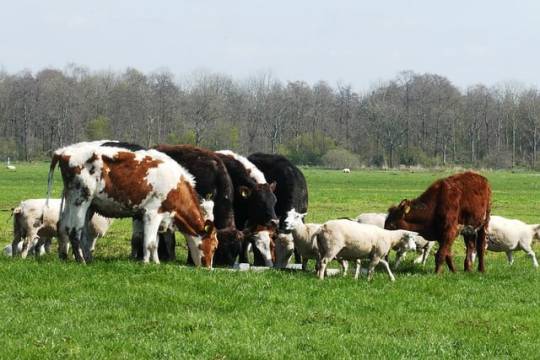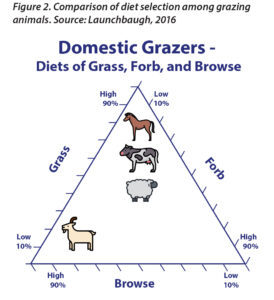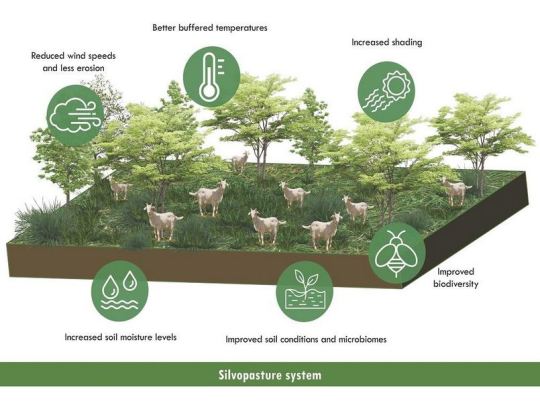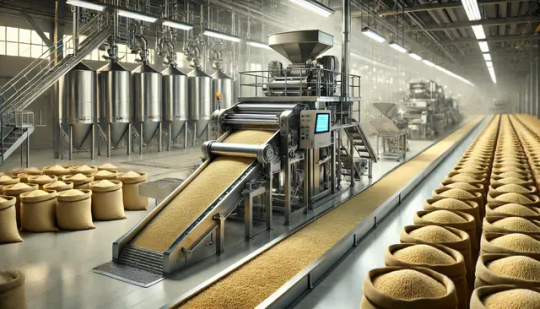#chemical pesticides in rice farming
Explore tagged Tumblr posts
Text
Study reveals invasive Apple Snail could spread further in Africa
New research led by CABI and including the Kenya Plant Health Inspectorate Service (KEPHIS) reveals that the invasive Apple Snail – which threatens rice crops – could spread further in Africa. A team of researchers from CABI’s regional centre for Africa in Nairobi, working with KEPHIS, suggest that South West along Tana River, Western Kenya and areas coastal areas are suitable for Apple Snail…
#African rice production#alternate wetting and drying#Apple Snail invasion#Apple Snail management#CABI research#chemical pesticides in rice farming#climate change and pests#coastal Kenya farming#crop yield loss#early warning systems for pests#economic impact of Apple Snail#food security in Kenya.#invasive species#Kenya rice farming#kephis#Madagascar agriculture#Malawi rice farmers#mechanical control of snails#Mozambique rice pests#Mwea irrigation scheme#National Irrigation Authority#pest control in Africa#quarantine measures#rice crop protection#rice pests#rice value chain stakeholders.#sustainable rice farming#Tana River rice farming#Tanzania agriculture#Uganda rice production
0 notes
Text
VallaaraiRice Mix– Natural Products - MyTapas
Boost your meals with Vallaarai Rice Mix from Mytapas! Packed with Vallaarai, a herb known for promoting cognitive health. Tasty, nutritious, and wholesome! Order now at [email protected]!
#My Tapas#Organic#Natural#Pesticide-free#Eco-friendly#Organic products#Herbal products#Farm-to-table#Chemical-free#Bio-degradable#Health-conscious#Organic certification#Nutrient-dense#Organic Foods#Organic Spices#Organic pickles#Herbal Rice Mix.#vallarai rice mix
2 notes
·
View notes
Text
Permaculture Methods


Mixed Grazing: grazing a flock of multiple species together in Pasture, such as cattle, sheep and goats. Each species has different dietary needs and are able to graze on different plants in the Pasture keeping weeds down and using acreage more efficiently. Cattle prefer grass, sheep prefer weeds, while goats like brush and forage. The animals also graze at different levels, cattle tall, sheep short, and goats climbing. A mixed flock is also healthier because each species has its own unique parasites that will not spread to members of a different species.


Silvopastoralism: grazing Livestock in Orchards and vineyards. The animals keep the grass and weeds down in the Orchards which helps keep the trees healthy. They fertilize the Orchards with their manure. Of course, as with most types of integrated farming it really helps save space for the smaller farmer or homesteaders.


Integrated rice farming is done is Asia, using a variety of animals to help benefit the production of rice. The most common being rice-duck-fish farming, where fish are farming in channels around the rice field and ducks are released into the paddies. The fish and ducks fertilize the rice and keep pests at bay, especially mosquito larvae which can easily run rampant in a swampy rice field. The ducks and fish naturally replace the need for chemical fertilizers and pesticides.

As a bonus: a lot of rice farmers use the water buffalo to plough the field, this animal is naturally at home in the swampy environment of the rice paddy. Aside from ploughing, the water buffalo is also used as a source of milk, meat and hide.


Intercropping/Companion Planting: planting different species of crops together that will have beneficial effects to each other. The most ancient intercropping is growing cereals and pulses (legumes) together, as the legumes provide lots of nitrogen that helps the grains grow. The Three Sisters is variation of this, combining maize (grain) with beans (legume) but also incorporating squash into the mix which help keeps weeds and pests like raccoons at bay with their sprawling prickly leaves. This system will work interchangeably with any grain, pulse or Marrow (the Marrows are squash, gourds, melons and Cucumbers).
Some other combinations we like to use are Root veg + Leafy green. We intercrop carrots with spinach (and beets with lettuce), the crops don't compete with another for space as one crop mainly grows up and the other grows down, the leafy greens also shade the root rows and help keep weeds down.
I think everyone's heard of the Tomato + Basil intercropping, and how the basil keeps tomato pests at bay and help flavour the tomatoes. We use this system with other nightshades (Eggplant and Peppers) as well, basil is a herb in the Mint family so we substitute basil for other herbs too (summer savory, marjoram).
20 notes
·
View notes
Text
“Dirty hands, clean money”
Organic farmers in Altamira are working to change the culture of a region where many people think nothing of using pesticides to kill weeds and insects. As well as the fight against entrenched attitudes, they face economic and climate challenges

Organic farmers in Altamira are working to change the culture of a region where many people think nothing of using pesticides to kill weeds and insects. As well as the fight against entrenched attitudes, they face economic and climate challenges
Sebastião Heraldo Lira Gomes has done a bit of everything, from soiling his hands in the yellow mud of Brazil’s gold-mining regions to digging in the black soil of a vegetable garden. In his 45 years, he has worked for construction and asphalting companies, at brick plants, and even as a gold prospector. In the mines, his life once hung by a thread when he was digging branches out of the mud to clean off material to be mined. An alarmed co-worker pointed to a mountain of tailings and shouted a warning: “The barrier is going to collapse.” It did, and Sebastião narrowly escaped. He told this story while planting a row of lettuce seedlings in his organic garden in Altamira, a city in southwestern Pará.
“Mining is an adventure. You head out not knowing whether you’ll come back,” Sebastião says. He survived the dangers but never returned to the mines. Born on a small farm on Bacabal, an island in the Xingu River, Sebastião grew up helping his family plant rice, beans, corn, and cassava. Until the age of 25, he followed in his parents’ footsteps, but then he moved to Altamira, where he held a number of jobs. In 2021, at the suggestion of his wife, Alderene, 51, he left mining and decided to make farming a source of income, hoping to enjoy the security of working on his own land while being close to his family.
When he contacted the Pará state rural extension agency Emater, the agent Joabe dos Santos asked him, “Why don’t you plant organic produce?” Sebastião didn’t even know what organic food was. His family had never used pesticides on their crops. Indigenous peoples, Beiradeiros, and other traditional communities in the Amazon have always planted without relying on these poisons.
Organic farming emerged as a response to the growing application of pesticides and fertilizers on European crops following World War I (1914-1918). The practice aims to keep agricultural activities in balance with Nature through the adoption of modern production techniques and the responsible use of water and soil. Organic farming rejects chemical fertilizers and transgenic seeds, which have been modified to resist drought, pests, and pesticides. This approach to agriculture also strives to forge an environment of social justice and respect for both human labor and the more-than-human world.
Continue reading.
#brazil#brazilian politics#politics#environmentalism#farming#image description in alt#mod nise da silveira
3 notes
·
View notes
Text
Organic brown rice is a whole grain rice that is cultivated without the use of synthetic pesticides or fertilizers. It is unpolished and retains the bran and germ layers, making it a healthier option compared to white rice, which has been stripped of these parts during processing. The presence of these layers provides additional nutrients such as fiber, vitamins (especially B vitamins), minerals (like magnesium), and antioxidants.
Some benefits of organic brown rice include:
Higher nutritional content: It is rich in fiber, which aids digestion and helps in maintaining steady blood sugar levels.
Better for heart health: The antioxidants and fiber can contribute to a lower risk of heart disease.
Environmental benefits: Organic farming methods are better for the environment because they avoid the use of harmful chemicals and often promote sustainable agricultural practices.
When cooking organic brown rice, it typically requires a longer cooking time than white rice.
#Organic brown rice price#Organic brown rice benefits#Organic brown rice in india#Organic brown rice 5kg#Best organic brown rice#Organic brown rice brand
2 notes
·
View notes
Text
What Makes a Reliable Non-Basmati Rice Manufacturer?

Non-basmati rice is a staple food in many countries due to its affordable price, versatility, and varying grain sizes. From long-grain to short-grain varieties, it serves as the backbone of countless meals. But what’s the difference between an ordinary supplier and a reliable manufacturer when it comes to non-basmati rice? For wholesalers, retailers, and even consumers, choosing the right rice manufacturer can make a huge difference in quality, consistency, and long-term relationships. This blog will explore the key factors that ensure you’re sourcing from a trustworthy non-basmati rice manufacturer.
Quality Control Practices and Certifications
The foundation of any reliable rice manufacturer is its commitment to quality. Manufacturers with strict quality control processes ensure that each batch of rice meets specific standards for purity, grain length, moisture content, and taste. Look for manufacturers that adhere to international certifications such as ISO 9001 for quality management and HACCP (Hazard Analysis and Critical Control Points) for food safety. These certifications ensure that the rice is produced under clean conditions and undergoes rigorous testing to remove impurities.
Additionally, quality manufacturers often employ state-of-the-art testing laboratories that analyze rice for contaminants such as pesticides, aflatoxins, and heavy metals. This commitment to food safety ensures that you are getting a premium product that meets global standards.
Consistent Supply and Scalability
A reliable non-basmati rice manufacturer must be able to meet consistent demand, whether you are a small retailer or a large-scale distributor. This means maintaining adequate stock, having capacity for large orders, and increasing production as needed. Manufacturers with extensive farming networks or partnerships with multiple farmers can better guarantee stable supply throughout the year, regardless of seasonal fluctuations.
Scalability is especially important for businesses looking to expand into new markets. A trustworthy manufacturer will have the flexibility to adjust production volumes to align with your growth, ensuring a smooth supply chain even during peak seasons.
Technological advancements in milling and packaging
Modern rice milling and packaging technology plays a key role in maintaining the quality and shelf life of non-basmati rice. Reliable manufacturers invest in advanced milling machinery that reduces broken grains and preserves the natural texture and flavor of rice. Look for manufacturers that use automated sorting technologies to remove discolored or damaged grains, ensuring a more consistent product.
Packaging also matters. Vacuum-sealed or air-tight packaging helps preserve freshness and prevent moisture ingress, which can lead to spoilage or insect infestation. Manufacturers that adopt innovative packaging solutions help ensure that their rice reaches consumers in optimal condition.
Sustainable and ethical sourcing
As consumers and businesses are becoming more aware of sustainability, it is important to work with a manufacturer that values ethical sourcing. Reliable manufacturers prioritize environmentally friendly farming practices, such as minimizing the use of chemical pesticides and adopting water conservation methods. Some manufacturers also support small-scale farmers by offering fair trade agreements, ensuring that local communities benefit from their involvement.
Sustainably sourced rice also tends to be higher in quality, as the plants are grown in healthy soil, without an excessive reliance on synthetic chemicals. Look for manufacturers that openly share their sustainability initiatives or hold certifications such as Fairtrade or Organic to further validate their commitment to ethical practices.
Customer Support and Global Reach
Strong customer support is the hallmark of any reliable non-basmati rice manufacturer. A good manufacturer should provide clear communication channels, timely responses to inquiries, and efficient problem-solving when issues arise. This level of support fosters trust and ensures a seamless business relationship over time.
Additionally, manufacturers with a global reach and experience exporting rice to multiple countries are better equipped to handle the complexities of international shipping, customs regulations, and regional preferences. A manufacturer with a proven export track record can provide invaluable guidance, especially for businesses looking to expand internationally.
Choosing the right non-basmati rice manufacturer isn’t just about considering price. Quality control, supply continuity, technological advancements, consistency and customer support all play a vital role in ensuring you get a great product. By partnering with a reliable manufacturer, you can guarantee that your business will thrive and your customers will be happy.
2 notes
·
View notes
Text
Can Aquaculture Be Sustainable for Our Environment with the Right Approach?

Aquaculture--the method of farming saltwater and freshwater fish, shellfish, and aquatic plants--has become a reliable system over the past few decades for alleviating the world food demand, providing fish for consumption without overfishing, allowing economic relief for fishermen, rebuilding endangered species, etc. This practice has been widely used to better maintain the declining ocean fish population by creating farming approaches such as open-net pens, pond systems, closed systems, raceways, recirculation systems, suspended aquaculture, submersible net pens, etc. Additionally, aquaculture has relieved some fishermen's economic strain by providing coastal community jobs and lessening the need to overfish.
However, the many types of farms can vary with their risk to the environment and how controlled the areas are. Many farms can damage the outside waters because of potential contaminants in contact with specific systems. In contrast, some farms have less invasive methods and can be more sustainable with suitable regulations and ongoing improvements.
Various Farming Methods

Photo: Kelly Roebuck, open-net pen in BC
Open-net pens (cages) are placed directly into the water and moored at the bottom surface of the ocean, usually containing saltwater fish such as Atlantic salmon, trout, bluefin tuna, etc. They allow for contact between the farm and the outside environment, which risks the leakage of waste and chemicals, transfer of diseases, and escaping fish from damage to the cages. This threatens wild juvenile fish that may be interbred with farmed fish, which may transmit disease and alter the local gene pool. Not only that but without any regulation of pesticides and waste, the water that flows freely through the ocean and into the cages is not a controlled factor.
Watershed Watch Salmon Society Senior Scientist Stan Proboszcz reveals, "The fact of the matter is that many migrating fish have no choice but to pass by these farms.” This indicates the unavoidable encounter between farmed fish and wild fish in an open system.
Closed containment systems "use a barrier to control the exchange between farms and the natural environment." Some closed systems include ponds, tanks, recirculation technology, or raceways to limit the interaction with the outside habitat and are primarily used for freshwater species such as abalone, tilapia, and shrimp.
Pond culture is a popular method used in coastal Asian countries, with the area where fish reside contained in a small enclosed space in the ground. Species are raised, and feed is added to maintain their diet. Wastewater containing nitrogen and phosphorus used as fertilization for phytoplankton growth as a natural food base and other components such as bacteria, algae, and chemicals should be adequately filtered when discharged to be environmentally noninvasive. When unfiltered, it can lead to groundwater pollution in the outside environment.
Mangrove forests on the coast of Asian countries have been depleted because of alterations made to accommodate these fish and shrimp farms. The World Resources Institute evaluates that “nearly half the land now used for shrimp ponds in Thailand was formerly used for rice paddies; in addition, water diversion for shrimp ponds has lowered groundwater levels noticeably in some coastal areas.” This issue demonstrates the damaging effect of the need to create more shrimp ponds at the cost of natural mangrove ecosystems, salinization of soil and water, discharge of effluents resulting in pollution of the pond system and receiving waters, and misuse of chemicals. To combat this issue, the restoration and protection of mangrove habitats should be managed along with regulations regarding pond effluents, chemical use, and regional cooperation.
Recirculation technology cycles water through filtration processes and returns it to the aquaculture system. This process aids in maintaining water quality in natural waterways by minimalizing the potential for fish escapes, disease transmission, and pollution.
A semi-closed system exchanges the wastewater used in ponds for fresh natural water from outside sources. This method does not treat the water like recirculation technology but instead pumps out unfiltered water into the environment, which only increases pollution and damage to other fish.

Photo: Gary Fornshell, University of Idaho, flow-through tilapia farm near Boise, Idaho
Raceways are relatively straight, narrow, shallow tanks that need high water flow to sustain the aquatic life, usually rainbow trout, catfish, or salmon, raised there. They require large amounts of flowing water diverted from natural streams, streams, or wells to provide a high-quality water source. The main issue with raceways is the high release of effluents from fish fecal matter and uneaten feed, which flows into the receiving body of water.

Photo: Santryl, PEI oyster farm CC BY-NC 2.0
Suspended aquaculture uses cages, nets, or mesh bags with a rope to attach and drop shellfish such as oysters, scallops, mussels, or clams into a body of water. This method of vertically suspending shellfish only requires clean water and steady water flow to decrease the potential waste buildup. If the species is native to the environment as well, it can be a low-risk form of fish farming, and shellfish can naturally filter feed, allowing them to help restore waterways.
Although there are more aquaculture methods, the methods described above are the most popular ones that can cause low-risk or high-risk environmental damage. Some potential risks to the natural habitat that some farms pose have created a worry for environmentalists who believe that these intensive methods prioritize the output of fish while minimizing the input of resources to grow while harming the fish's lifestyle and environment economically. If fishing farms implement new and innovative solutions while continuing the minimally invasive methods, the future of aquaculture could be beneficial in further creating food security without causing irreparable damage.
Solutions
Some solutions to decrease the environmental impacts of aquaculture reside on multiple factors. In general, careful planning of the location, shipping, and aquaculture method by fisheries could lessen the impact. However, more specifically, to combat the issue of mangrove forest depletion, the restoration and protection of mangrove habitats should be managed along with regulations regarding pond effluents, chemical use, and regional cooperation. In other cases, research should be done to minimize waste matter in water before pumping it out into other water sources in recirculating methods. With the same thought in mind, new research should apply to different systems of cleaning wastewater instead of allowing it to contaminate surrounding areas. This way, methods directly contacting the ground or natural water sources can be more sustainable with their waste outputs. Another idea scientists have discussed is using an integrated cultivation system where fish such as finfish, oysters, sea cucumbers, and kelp are farmed together to take less space and have shellfish species that can clean the surrounding environment that has built up waste. Not only will this minimize space, but also help the effluents discharged.
The Ocean Foundation has composed an article discussing the effects of aquaculture along with some research scientists have done, as well as possible solutions. Their efforts and others, such as the National Oceanic and Atmospheric Administration, have created findings that will lessen the harmful effects of aquaculture, hoping for sustainable ways to provide food security and alleviate poverty.
Sources
youtube
#climate change#climate justice#earth#environment#environmentalism#epa#environmetalists#aquaculture#Youtube#fish
2 notes
·
View notes
Text
I love carbs too, and so does like everyone in the tags, the better way to voice it is “the amount of processing, chemicals, pesticides, insecticides, and other big farm practices has purposely made carbs and rice a more harmful and less nutritious product that is purposely processed to be less filling so you can go and buy more food, instead of being filled and of enjoying the life bread and carbs have given.”
The grains are not evil, the way we have harvested, exploited, and used grains are. Look at vegetables as an example:
In 1900, there were nearly 550 varieties of cabbage available in the United States; today only 28 varieties are sold commercially. With beets, the change is from 288 to 17. For cauliflower, from more than 150 to only 9. And corn? I hate to tell you? But we have lost over 96 precent of the corn varieties available at the start of the twentieth century.
—“Dirt to Soil” Gabe Brown
The problem is that the “health nut” and diet industry are trying to curb the side effects of this type of agriculture, not stop it— for the symptoms are wonderful profits. We are at a point where an American needs to eat a multivitamin a day to be healthy—which opens a new market to make profits. You will need to eat 10 of todays apples to get the nutritional value of 1 apple from the 1900s.
Look, I love grain and rice like the next human, but we are being victims of an industrial practice that cares more about the money we spend for food rather than the quality and health we get from the food, and it is destroying us and the only solution some have found is to stop eating bread but it does not curb the industrial practices—it’s like someone stop using plastic straws doesn’t stop all the plastic straws that are still being produced.
I’ll end on this note—because I can talk about this forever—Wendell Berry has noted in his book “The Unsettling of America” that in the 1970’s that many of the leaders of policy started seeing “Food is a weapon” and a weapon that can be industrialized for not only our survival but for our power, “Agripower” and “agridollar” specifically. But what it has been done instead is make a family and community run farms into factories with food as the weapon— this is why I think the United States voted no at the UN that food is a right, it is just another private industry that is “empowering us” and should not be shared, while depriving us of much. Thus, this is the world of food that capitalism has built for us to starve in.
‘bread is bad for you’ ‘rice is bad for you’ sorry im not subscribing to the idea that staple grains that have been integral to cultures for centuries are evil. i love you carbs
129K notes
·
View notes
Text
Common Applications of PP Woven Fabric in Agriculture and Farming
PP woven fabrics are a versatile and durable material widely used across industries, particularly in agriculture and farming. These fabrics, crafted by leading PP woven fabric manufacturers in India, are known for their strength, flexibility, and cost-effectiveness. This blog explores the common applications of PP woven fabric bags and PP woven sack bags in the agricultural sector.
What is PP Woven Fabric?
Polypropylene (PP) woven fabric is made by weaving polypropylene threads to create a strong, lightweight material. It is highly resistant to wear and tear, moisture, and chemicals, making it ideal for agricultural and farming applications.
Applications of PP Woven Fabric in Agriculture
1. Packaging of Agricultural Products
Grain Storage: PP woven sack bags are commonly used for storing and transporting grains like wheat, rice, and maize.
Fertilizers and Seeds: PP woven fabric bags provide a reliable solution for packaging fertilizers, seeds, and other agricultural inputs.
Fruits and Vegetables: These bags ensure that fresh produce is safely transported without damage.
2. Erosion Control
PP woven fabrics are used in geotextiles to prevent soil erosion. They act as a barrier to protect soil from water and wind, making them essential in agricultural landscapes and construction.
3. Mulching and Weed Control
PP woven fabric sheets are used as mulch to retain soil moisture and prevent weed growth.
They are particularly useful in controlling weeds without relying on chemicals, ensuring a sustainable farming approach.
4. Shade and Cover Applications
Greenhouse Covers: PP woven fabrics are used as covers for greenhouses to regulate temperature and protect crops from harsh weather.
Crop Protection: These fabrics act as a shield against pests, excessive sunlight, and rain.
5. Storage and Transportation
Bulk Packaging: Farmers and distributors rely on PP woven fabric bags for bulk storage and transportation of goods like animal feed and hay.
Chemical Resistance: The material’s resistance to moisture and chemicals makes it ideal for storing pesticides and other agricultural chemicals.
Why Choose PP Woven Fabric for Agriculture?
Durability: The fabric’s strength ensures long-term use, even under challenging conditions.
Cost-Effective: PP woven fabric bags are affordable, reducing packaging costs for farmers.
Lightweight: Easy to handle and transport, making operations more efficient.
Customizable: PP woven fabric manufacturers in India offer tailored solutions, such as printing logos or product details on the bags.
Role of PP Woven Fabric Manufacturers in India
India is a leading producer of high-quality PP woven fabrics, with manufacturers focusing on innovation and sustainability. PP woven sack bag manufacturers cater to both domestic and international markets, providing solutions tailored to the unique needs of agriculture and farming.
Conclusion
PP woven fabric has revolutionized agriculture and farming with its durability, versatility, and cost-efficiency. From packaging grains to protecting crops, its applications are vast and indispensable. By partnering with reliable PP woven fabric manufacturers in India, farmers can access high-quality products that enhance productivity and sustainability in their operations.
0 notes
Text
Why Organic Ghee is the Golden Elixir Your Kitchen Needs

What is Organic Ghee?
Organic ghee is a clarified butter made using traditional methods from the milk of grass-fed cows. What sets it apart from regular ghee is the purity and sustainability involved in its production. Organic ghee is free from synthetic hormones, antibiotics, pesticides, and preservatives, ensuring a clean and wholesome product.
With roots in ancient Ayurveda, ghee has been used for thousands of years as both a dietary staple and a medicinal ingredient. Its role in promoting health and longevity makes it a favorite in holistic health circles even today.
The Nutritional Power of Organic Ghee
Organic ghee isn’t just another fat; it’s a nutrient-rich powerhouse. Here are some of its most notable benefits:
Rich in Essential Vitamins Organic ghee is packed with fat-soluble vitamins such as A, D, E, and K. These nutrients are essential for maintaining strong bones, improving vision, and boosting immunity.
Loaded with Healthy Fats While fats often get a bad rap, the healthy fats in organic ghee are beneficial for the body. It contains omega-3 and omega-6 fatty acids, which promote heart health, regulate cholesterol, and support brain function.
Supports Digestion Ghee is an excellent source of butyric acid, a short-chain fatty acid known for its role in maintaining gut health. It aids digestion, reduces inflammation in the digestive tract, and supports the growth of good gut bacteria.
Boosts Metabolism Contrary to popular belief, moderate consumption of organic ghee can actually aid in weight management. Its medium-chain triglycerides (MCTs) are known to boost metabolism, providing a steady source of energy.
Antioxidant-Rich Organic ghee is a natural antioxidant, helping combat free radicals in the body. This can slow down aging and reduce the risk of chronic diseases.
Why Choose Organic Ghee Over Regular Ghee?
While regular ghee may seem similar, organic ghee is a superior choice for several reasons:
Purity and Quality: Organic ghee is made from grass-fed cow’s milk and processed without chemicals, ensuring a clean and safe product.
Enhanced Flavor: The natural process of making organic ghee enhances its nutty, aromatic flavor, making your dishes taste even better.
Eco-Friendly Farming: Choosing organic ghee supports sustainable farming practices that protect the environment.
Higher Nutritional Value: Studies suggest that organic dairy products are richer in nutrients compared to their non-organic counterparts.
How to Incorporate Organic Ghee into Your Daily Diet
Organic ghee is incredibly versatile, making it easy to include in various recipes. Here are some creative ways to use it:
Cooking and Frying Thanks to its high smoke point, organic ghee is perfect for sautéing, frying, and deep-frying. Unlike other oils, it doesn’t break down into harmful compounds at high temperatures.
Baking Substitute ghee for butter in baked goods like cookies, cakes, and muffins. Its rich flavor adds a unique depth to your treats.
Spreading and Topping Use organic ghee as a spread on toast or drizzle it over steamed vegetables, rice, or soups for added richness.
Ayurvedic Remedy For centuries, ghee has been used in Ayurveda to promote overall health. Try mixing a teaspoon of organic ghee into warm milk or herbal tea to soothe your body and mind.
Seasoning and Flavoring Add a spoonful of ghee to your curries, dal, or khichdi for an authentic and aromatic Indian touch.
Health Benefits Backed by Science
Recent studies highlight the health benefits of organic ghee:
Supports Heart Health: The omega-3 fatty acids in ghee help reduce bad cholesterol levels and increase good cholesterol, supporting cardiovascular health.
Improves Brain Function: Rich in healthy fats, organic ghee is known to enhance cognitive functions, memory, and focus.
Anti-Inflammatory Properties: Ghee’s natural anti-inflammatory compounds help reduce joint pain, swelling, and other inflammatory conditions.
Why KP e-Mart is Your Best Choice for Organic Ghee
When it comes to buying organic ghee, quality matters. At KP e-Mart, we offer premium organic ghee made from the finest grass-fed cow’s milk. Our ghee is free from preservatives and artificial additives, ensuring you receive the purest product for your health and wellness journey.
By choosing KP e-Mart’s organic ghee, you’re not just investing in better health but also supporting sustainable farming practices that benefit the planet.
Conclusion
Organic ghee is more than just a cooking ingredient — it’s a superfood that offers unparalleled health benefits. From improving digestion and boosting immunity to enhancing the flavor of your meals, this golden elixir is a must-have in every home.
Make the switch to organic ghee today with KP e-Mart and experience the perfect blend of tradition, nutrition, and sustainability. Your health and taste buds will thank you!
0 notes
Text

Organic Dehradun Basmati Rice
At Dehradun Mart, we take pride in being the premier shopping destination in the beautiful city of Dehradun. Established with a vision to offer a delightful shopping experience, we bring together a diverse range of products and services, catering to the needs of our esteemed customers. Dehradun mart founded in February 22′ by Mr. Arvind Singh Rawat. Our main focus is Organic products and farmers play a vital role in promoting sustainable agriculture and safeguarding the environment. Organic farming emphasizes the use of natural practices and avoids synthetic chemicals, GMOs, and pesticides, ensuring the integrity of the soil and the well-being of the ecosystems. Organic farmers work hand in hand with nature, employing techniques such as crop rotation, composting, and integrated pest management to maintain healthy and resilient crops.
0 notes
Text
Mango Vinegar– Natural Products - MyTapas
Enjoy the fruity sweetness of mangoes with the tangy kick of vinegar in Mytapas’ Mango Vinegar. A perfect probiotic for dressings, marinades, and beverages. Order now: [email protected]!
#My Tapas#Organic#Natural#Pesticide-free#Eco-friendly#Organic products#Herbal products#Farm-to-table#Chemical-free#Bio-degradable#Health-conscious#Organic certification#Nutrient-dense#Organic Foods#Organic Spices#Organic pickles#Herbal Rice Mix.#Mango Vinegar
0 notes
Text
BusyBeans Organic Food: The Gateway to a Healthier Lifestyle
In today’s fast-paced world, where processed and artificial foods dominate supermarket shelves, finding pure, organic food can feel like a treasure hunt. Thankfully, BusyBeans Organic Food simplifies the journey toward healthy living by offering a range of 100% organic and eco-friendly products.
Why Choose BusyBeans?
At BusyBeans, the philosophy revolves around “Food as Nature Intended.” Every product is grown without synthetic fertilizers or pesticides, ensuring you consume food in its purest form. Here’s why BusyBeans stands out:
Nutritional Richness Organic food retains its natural nutrients, offering you the vitamins and minerals your body needs without harmful additives. BusyBeans ensures that every product delivers optimal nourishment.
Eco-Friendly Farming Practices By promoting sustainable agriculture, BusyBeans not only supports your health but also protects the environment. Their farmers use eco-friendly practices that preserve soil health and biodiversity.
No GMOs, No Chemicals BusyBeans’ commitment to quality means you can trust that there are no genetically modified organisms or harmful chemicals in your food. It’s the natural way to eat clean and live green.
Explore the BusyBeans Range
BusyBeans caters to all your dietary needs with its diverse product line:
Whole Grains: Rice, quinoa, and other staples to power your meals.
Fresh Produce: Vibrant fruits and vegetables picked at their peak.
Dairy & Alternatives: Organic milk, butter, and plant-based options.
Snacks & Beverages: Healthy treats and drinks for guilt-free indulgence.
The BusyBeans Promise
BusyBeans is more than a brand; it’s a community dedicated to spreading health and wellness. With a focus on traceability, transparency, and trust, the team ensures that every product reaching your plate is of the highest standard.
Make the Switch Today
Switching to organic food isn’t just a lifestyle change; it’s an investment in your health and future generations. Join the BusyBeans movement today and embrace the power of organic living.
0 notes
Text
The Hidden Benefits of Potassium Silicate for Disease-Resistant Crops

Modern agriculture faces countless challenges, but one of the most pressing issues is crop disease. From fungal infections to bacterial attacks, diseases can drastically reduce yield, affecting both the quality and quantity of harvests. While traditional methods like chemical pesticides help, they often come with environmental and financial drawbacks. This is where potassium silicate liquid fertilizer emerges as a sustainable and effective solution.
In this blog, we’ll uncover the hidden benefits of potassium silicate and why it is becoming an essential component for cultivating disease-resistant crops.
What is Potassium Silicate, and Why is it Vital for Crops?
If you’re unfamiliar with potassium silicate, let’s start with the basics. Potassium silicate is a water-soluble compound that combines potassium (K) and silica (Si). These two nutrients are critical for plant growth and development, playing essential roles in strengthening plant structures and enhancing their ability to combat stress.
So, what makes potassium silicate stand out compared to other fertilizers? The answer lies in its dual-action mechanism:
Nutrient Provider: Potassium silicate supplies silica, which plants use to build stronger cell walls. This fortifies plants against environmental stressors and pathogens.
Disease Fighter: The silica content acts as a barrier, making it harder for pathogens to penetrate the plant tissues.
By focusing on long-term plant health rather than quick fixes, potassium silicate ensures robust crop growth and improved disease resistance.
How Does Potassium Silicate Protect Crops from Diseases?
1. Enhancing Plant Cell Walls
One of the primary ways potassium silicate boosts disease resistance is by strengthening plant cell walls. Think of silica as the plant’s armor—it fortifies the outer layer, making it difficult for harmful fungi, bacteria, and viruses to breach.
2. Triggering Natural Defense Mechanisms
Potassium silicate doesn’t just act as a physical shield; it also triggers the plant’s natural immune responses. When a plant senses silica, it activates its defense mechanisms, such as producing antimicrobial compounds that neutralize pathogens.
3. Reducing Susceptibility to Pathogens
By improving the overall health of the plant, potassium silicate reduces the likelihood of infections taking hold. Healthier plants are naturally more resilient, and potassium silicate ensures they have the strength to fend off diseases effectively.
4. Inhibiting Spore Germination
Potassium silicate creates unfavorable conditions for spore germination on plant surfaces. This means that even if fungal spores land on your crops, they are less likely to grow and cause infections.
What Crops Benefit the Most from Potassium Silicate?
Wondering if potassium silicate is suitable for your crops? It is incredibly versatile and can be used across a wide range of plants, including:
Tomatoes: Protects against blight and improves fruit quality.
Rice and Wheat: Boosts tolerance to fungal diseases like powdery mildew and leaf rust.
Cucumbers: Enhances resistance to downy mildew and improves yield.
Bananas: Reduces susceptibility to sigatoka and other fungal infections.
Ornamental Plants: Improves aesthetics and prevents common diseases like leaf spots.
By incorporating potassium silicate into your farming practices, you can target disease-prone crops and significantly reduce yield losses.
How Does Potassium Silicate Compare to Traditional Fertilizers?
Farmers often rely on traditional fertilizers for plant nutrition, but these rarely address disease resistance. Here’s how potassium silicate stands out:
Focus on Prevention: Unlike chemical treatments that target diseases after they appear, potassium silicate helps prevent infections before they occur.
Eco-Friendly Solution: Reduces the need for synthetic pesticides, promoting sustainable farming practices.
Improves Soil Health: Potassium silicate contributes to long-term soil improvement, unlike chemical fertilizers that may degrade soil quality over time.
By combining potassium silicate with other farming techniques, you can achieve a more holistic approach to crop management.
How Can Potassium Silicate Reduce Pesticide Usage?
The overuse of pesticides in farming is a well-documented issue, leading to soil degradation, water pollution, and pesticide-resistant pests. Potassium silicate offers an eco-friendly alternative by:
Reducing Pesticide Dependence: Healthier, silica-fortified plants require fewer chemical treatments.
Promoting Eco-Friendly Practices: Fewer pesticides mean a reduced environmental footprint.
Cost Savings for Farmers: Less spending on chemical inputs translates to better profit margins.
Can Potassium Silicate Combat Abiotic Stresses Too?
Crops are not just threatened by diseases; they also face challenges like drought, salinity, and extreme temperatures. Potassium silicate helps in this regard as well:
Drought Resistance: Silica reduces water loss by forming a protective layer on plant leaves.
Salinity Tolerance: Potassium silicate minimizes the toxic effects of saline soils, ensuring better growth.
Heat Stress Mitigation: Enhances the plant’s ability to endure high temperatures without compromising yield.
By addressing both biotic (disease) and abiotic (environmental) stresses, potassium silicate proves to be an indispensable tool for modern farmers.
How to Use Potassium Silicate for Maximum Benefits
To make the most of potassium silicate, it’s important to apply it correctly. Here’s a quick guide:
Dosage: Follow manufacturer recommendations based on crop type and growth stage.
Application Method: Use it as a foliar spray or soil drench for effective absorption.
Timing: Apply during early growth stages and continue periodically throughout the crop cycle.
Compatibility: Ensure compatibility with other fertilizers or pesticides to avoid adverse reactions.
By adopting these practices, you can maximize the benefits of potassium silicate for your crops.
Why Choose Noble Alchem for Potassium Silicate?
At Noble Alchem, we understand the importance of quality and sustainability in agriculture. Our potassium silicate liquid fertilizer is formulated to deliver maximum benefits, ensuring your crops stay healthy and disease-free. Here’s why farmers trust us:
High-Quality Products: Our potassium silicate is manufactured to meet industry standards, offering consistent results.
Eco-Friendly Solutions: We prioritize sustainability, helping you reduce your environmental impact.
Expert Support: Our team of agricultural experts is always ready to assist you with product recommendations and usage tips.
Whether you’re growing vegetables, cereals, or ornamental plants, Noble Alchem’s potassium silicate is the perfect partner for achieving healthier, disease-resistant crops.
Conclusion: The Future of Disease-Resistant Farming
As crop diseases continue to threaten global food security, innovative solutions like potassium silicate are more important than ever. By strengthening plant defenses, reducing pesticide usage, and combating abiotic stresses, potassium silicate offers a sustainable pathway to resilient agriculture.
Ready to transform your farming practices? Discover the benefits of Noble Alchem’s potassium silicate liquid fertilizer today. Contact us for more information or to place your order, and take the first step towards healthier crops and higher yields.
Get in Touch with Noble Alchem Now!
0 notes
Text
Orgalife Organic Brown Rice is a premium, healthy alternative to regular rice, tailored for individuals who prioritize wellness and sustainability in their diet. Here’s what makes it stand out:
Key Features
100% Certified Organic:
Free from synthetic chemicals, pesticides, and GMOs.
Sourced from eco-friendly farms committed to sustainable agriculture.
Nutrient-Dense Whole Grain:
Retains the bran and germ layers, making it rich in fiber, vitamins (B-complex), minerals (magnesium, phosphorus), and antioxidants.
Low Glycemic Index:
Ideal for diabetics and those managing blood sugar levels.
Natural Flavor & Texture:
A nutty, earthy flavor combined with a chewy texture, perfect for diverse culinary uses.
Health Benefits
Supports Weight Management: Keeps you feeling full longer due to its high fiber content.
Promotes Heart Health: Contains magnesium and selenium, which support cardiovascular well-being.
Aids Digestion: High in dietary fiber, which promotes a healthy gut.
Boosts Immunity: Packed with essential nutrients that help strengthen the immune system.
Why Choose Orgalife?
Sustainability: Grown using environmentally friendly practices to preserve soil health and biodiversity.
Purity Guaranteed: Regular quality checks ensure the product is safe, pure, and nutritious.
Ethically Sourced: Supports local farmers and communities engaged in organic farming.
Usage Ideas
Main Course: Serve it as a healthier substitute for white rice in daily meals.
Salads: Mix with vegetables, nuts, and a light dressing for a wholesome bowl.
Rice Bowls: Pair with lentils, tofu, or grilled veggies for a hearty, balanced meal.
Desserts: Use in rice pudding or other creative recipes.
Packaging
Available in 1kg and 5kg packs with eco-friendly, resealable packaging to retain freshness.
Elevate your meals with Orgalife Organic Brown Rice—a choice that’s not only healthy for you but also kind to the planet.
#Organic Brown Rice#Organic brown rice price#Organic brown rice benefits#Organic brown rice in india#Organic brown rice 5kg#Best organic brown rice#Organic brown rice brand
1 note
·
View note
Text
How Indian Basmati Rice Suppliers Ensure the Best Grain Quality

Indian Basmati rice is renowned across the world for its exceptional aroma, delicate flavour and extra long grains. It is no wonder that global buyers look to India as the leading hub for premium quality rice. But what sets Indian rice exporters apart in ensuring this unmatched quality? The secret lies in their meticulous processes and adherence to stringent standards. From sourcing to processing, every step is carefully managed to deliver the finest grains.
This blog highlights the strategies that make Indian rice manufacturers and suppliers synonymous with top quality in the global market.
Introduction to Indian Basmati Rice Quality Standards
India is the world’s largest exporter of Basmati rice, accounting for over 65% of global exports. The Geographical Indication (GI) tag given to regions in northern India ensures authenticity. Following these quality criteria, Indian rice suppliers prioritize strict compliance with international and domestic standards such as ISO 22000 and HACCP certification.
Reputed suppliers ensure that each grain meets these standards by integrating a blend of traditional farming and modern technology. This blend assures buyers of quality, taste, and authenticity in every shipment.
Sourcing High-Quality Basmati: Farm-to-Factory Practices
The journey of basmati rice begins in the fertile fields of northern India, primarily in Punjab, Haryana, and Uttar Pradesh. Indian rice manufacturers prioritize sustainable farming practices and work directly with farmers to ensure the highest-quality crop.
Seed Selection: Only certified basmati seeds are used to maintain purity. Suppliers often collaborate with agricultural experts to train farmers on seed selection and crop management.
Farm monitoring: Many exporters employ agronomists to monitor the farms during cultivation, ensuring that practices such as crop rotation, water management, and organic fertilizers are used.
These practices guarantee high-quality paddy that is free from chemical residues and pests, laying the foundation for superior grain quality.
Advanced processing techniques for superior grain quality
After harvesting, paddy undergoes precise processing to retain its unique characteristics. Indian rice suppliers use advanced techniques along with traditional methods to make the grain flawless.
State-of-the-art milling: Modern rice mills equipped with automated husking, polishing, and grading systems preserve the natural aroma and nutritional value of the grain.
Sorting and grading: Optical sorting machines detect and remove impurities, discolored grains, and broken grains, ensuring uniformity in size and quality.
Aging: Aging is the hallmark of premium Basmati rice. Suppliers store the rice in a controlled environment for up to 12 months, enhancing its texture and aroma.
By focusing on these processing techniques, Indian rice manufacturers consistently deliver grains that meet global expectations.
Rigorous quality control measures in supplying Basmati rice
Indian rice exporters are known for their rigorous quality checks at every stage of production. These checks ensure that the grains meet not only Indian standards but also international buyer requirements.
Laboratory testing: Samples from each batch undergo extensive laboratory testing for moisture content, elongation ratio, and purity.
Residuary analysis: Suppliers ensure compliance with international standards for pesticide and chemical residue limits.
Traceability: Modern traceability systems help buyers track the origin and quality of rice from farm to shipment, thereby building trust in the supply chain.
Such strict quality control measures strengthen the reputation of Indian rice suppliers as reliable and trustworthy partners for global buyers.
Global Recognition and Certification for Indian Basmati
Indian rice manufacturers have earned several certifications that underscore their commitment to quality. Some of the most recognized certifications include:
ISO 9001 and 22000: For quality management and food safety.
Non-GMO certification: Assures buyers of natural, unaltered grains.
Organic certification: Caters to buyers looking for eco-friendly and health-conscious products.
Additionally, the GI tag for Basmati rice has helped secure India’s position as a premium rice supplier in the global market. Buyers rely on these certifications as proof of the authenticity and quality of the product.
Indian rice suppliers’ commitment to excellence begins with the farmers and progresses through advanced processing, rigorous quality checks, and adherence to global standards. This meticulous approach not only ensures the top quality of Basmati rice but also maintains India’s reputation as a leading rice exporter worldwide.
For global buyers looking for reliability, authenticity, and premium quality, Indian rice exporters remain the ideal choice. Their dedication to maintaining the integrity of Basmati rice guarantees satisfaction with every shipment.
1 note
·
View note